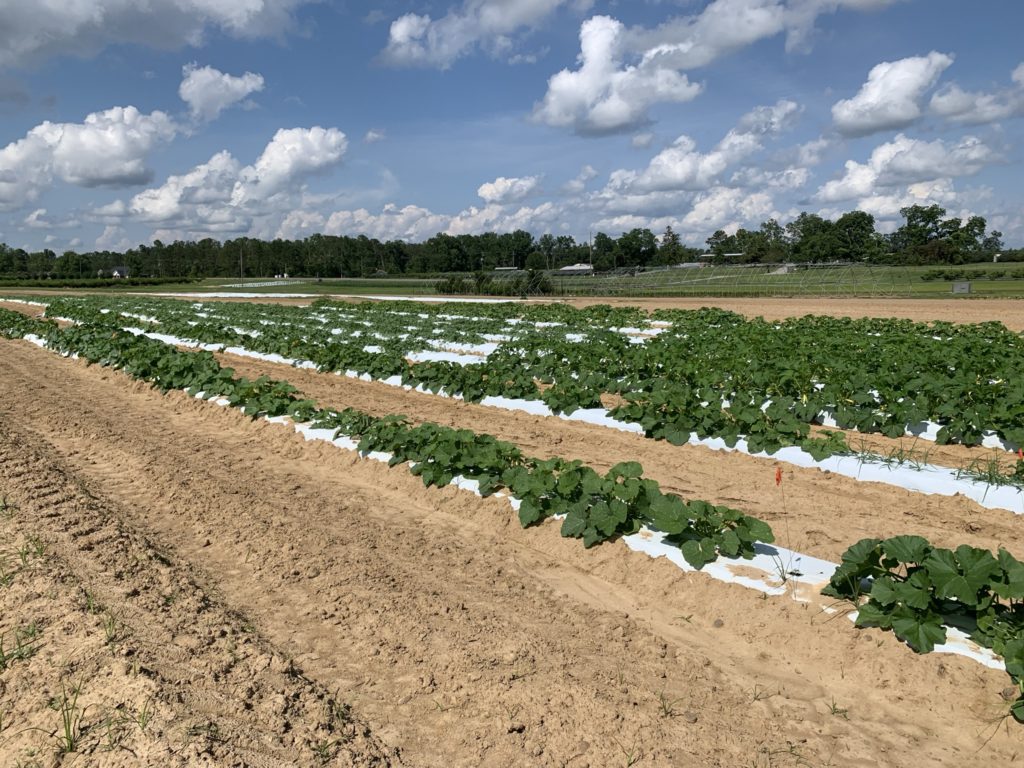
By Ayanava Majumdar, Olivia Fuller, David Lawrence and Jacob Kelley
Have you faced the full onslaught of squash bugs and been frustrated with dead squash plants? Have you battled cucumber beetles and squash vine borers on your farm? If you answered “yes” to one of these questions and are looking for sustainable integrated pest management practices, then it is time to included trap cropping and organic insecticides into your production process.
This article summarizes advances in Hubbard squash trap crop research in Alabama that has been funded by Sustainable Agriculture Research and Education, U.S. Department of Agriculture-National Institute of Food and Agriculture Crop Protection and Pest Management Program, Organic Research and Education Initiative and Alabama Department of Agriculture’s Specialty Crop Block Grant Program.
Hubbard squash (Cucurbita maxima) is a type of winter squash that bears large greenish-blue fruits with a yellow interior when ripe. This is a perfectly edible trap crop with vines reaching 10 feet or more. Due to its aggressive growth habit, the plant establishes rapidly and bears large green leaves that attract cucumber beetles, squash bugs and vine borers.
Typically, cucumber beetles are worse earlier in the season in Alabama with high numbers attacking the seedlings. Squash vine borers, that are monitored using sticky wing pheromone traps (highly recommended if you are a beginning farmer!), typically start flight in February or March in Alabama with moths laying eggs at plant bases. Squash bugs come next and compete with all the previous insects.
Tips for Success
Under such high pest pressure, it is recommended to plant Hubbard squash trap crops two to three weeks ahead of the main crop, which could be yellow squash, watermelon, etc. Plant the trap crops on good ground and treat it just like a main crop.
It is recommended to grow mixed stands of New England and Baby Blue Hubbard as perimeter trap crops since they have slight differences in stand establishment/growth characteristics and insect species they attract. When done right, Hubbard trap crops can consistently deter over 90% of cucumber beetles (early season), adults and eggs of squash bugs (mid-summer), and over 50% of squash vine borers in outbreak years like 2021.
Besides pest protection benefits, a good trap crop can provide additional benefits like reduced need for insecticide applications to the main crop, increase in the activity of native and introduced pollinators and beneficial insects, and reduction in weeds due to rapid ground cover. With good niche marketing, a healthy harvest of the large Hubbard squash fruits can bring in new customers and recover trap-crop costs.
What to Avoid
Don’t ignore the trap crops in any system you may be using. Planning is critical for full effect! Don’t plant trap crops on poor soil because stand establishment and rapid growth are the goals.
Don’t plant the trap crop more than 100 to 150 feet away from the main crop as squash bug numbers and egg masses increase with distance. Don’t plant Hubbard squash too close to the main crop either; 6 to 10 feet separation between the perimeter trap crop rows and the main crop will give the best effect. Physically move the Hubbard squash vines to the center.
Don’t forget to use insecticides on the Hubbard trap crops, especially pre-bloom, with low-persistence organic products to reduce squash bugs and cucumber beetles before they get a chance to move to the main crop. Assessment has found PyGanic, Entrust and Azera (premix) effective in combination and rotation on the trap crop. Don’t overuse insecticides in the late season. Treating Hubbard squash when it is in vegetative stages will save money in the long run.
Ayanava Majumdar is an Extension professor at Auburn University. Olivia Fuller, David Lawrence and Jacob Kelley are regional Extension agents for the Alabama Cooperative Extension System.









